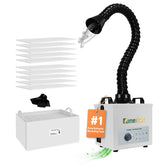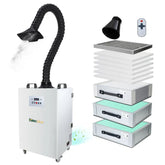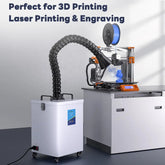Soldering is one of the most common processes in electronics manufacturing — and also one of the most overlooked sources of indoor air pollution. The smoke rising from your soldering iron tip contains fine particulates, rosin flux fumes, and volatile organic compounds (VOCs) that can irritate eyes, nose, and throat. Long-term exposure is linked to occupational asthma, chronic bronchitis, and other respiratory issues. The solution? A well-designed soldering fume extractor. In this comprehensive guide, you will learn why fume extraction matters, how these systems work, how to choose the right model, and how to set up and maintain it for maximum efficiency.
1) Health Risks of Soldering Fumes
When rosin-core solder melts, it releases a visible white smoke — actually an aerosol of fine particles and chemicals such as aldehydes, organic acids, and resin acids. These can cause short-term symptoms like eye irritation, coughing, and headaches. Chronic exposure can lead to long-term health effects such as:
- Occupational asthma: Studies show workers regularly exposed to solder fumes are several times more likely to develop asthma-like symptoms.
- Respiratory inflammation: Chronic bronchitis and reduced lung function are common in unventilated workshops.
- Metal fume fever: If using lead-free solder with higher temperatures, zinc and copper oxides may contribute to flu-like symptoms.

2) How a Soldering Fume Extractor Works
A modern soldering fume extractor combines airflow with multi-stage filtration to capture and neutralize contaminants. The basic components include:
- Pre-filter: Traps large dust and solder splatter, protecting the main filter stages.
- HEPA filter: Removes ≥99.97% of fine particles down to 0.3 µm — critical for protecting lungs.
- Activated carbon: Adsorbs VOCs, flux odors, and other gases that would otherwise linger in the air.

3) Choosing the Right Fume Extractor
Selecting the right soldering fume extractor depends on your workstation setup, number of operators, and airflow requirements. Here are recommended models:
- FumeClear FC-100A — A compact entry-level unit perfect for light-duty soldering tasks and small workbenches.
- FumeClear FC-2001A — A single-arm unit ideal for medium soldering workloads, featuring efficient three-stage filtration.
- FumeClear FC-2002A — With 153 CFM and ESD-safe housing, perfect for production lines and high-volume work.
- FumeClear FC-1002A — Dual-arm, 194 CFM powerhouse supporting two simultaneous operators.
4) Setup & Hood Placement
Even the best extractor fails if the hood is too far from the fume source. Keep the hood 5–10 cm (2–4 in) from the soldering tip and position it in line with the rising plume. Avoid sharp hose bends and ensure airflow is not blocked by tools.
5) Maintenance & Filter Replacement
Regular maintenance ensures consistent performance and keeps operators safe.
| Filter Stage | Function | Replacement Interval |
|---|---|---|
| Pre-filter | Captures large dust & splatter | Every 2 weeks |
| HEPA | Traps fine particulates | Every 2–4 months |
| Carbon | Adsorbs VOCs & odors | Every 3–6 months (sooner if odors return) |

6) Case Study: PCB Assembly Line Upgrade
A small PCB assembly shop with ten soldering stations was facing strong odors and worker complaints. They installed five dual-arm FC-1002A units and set up a maintenance rotation for pre-filter changes every two weeks. Results after one month:
- Visible smoke reduced by >90%
- Employee comfort significantly improved
- Absenteeism due to respiratory irritation dropped
- Filter replacement costs decreased thanks to scheduled pre-filter swaps
7) Quick Checklist
- ✅ Hood within 5–10 cm of solder tip
- ✅ Filters replaced on schedule
- ✅ Airflow ≥ 100 CFM at capture point
- ✅ Hoses free of kinks and leaks
- ✅ Extractor runs for 2–3 minutes post-job
Ready to Protect Your Team?
Explore professional soldering fume extractors and accessories here:
































